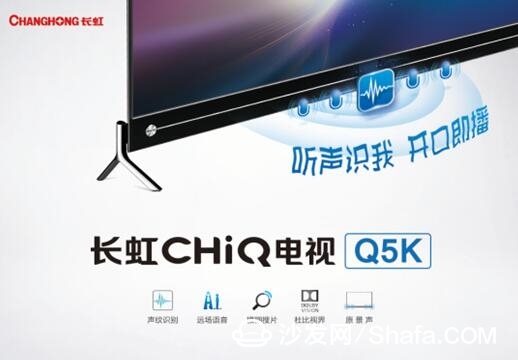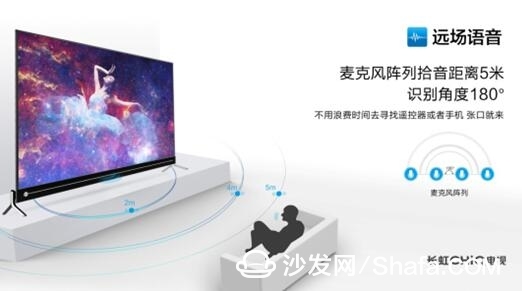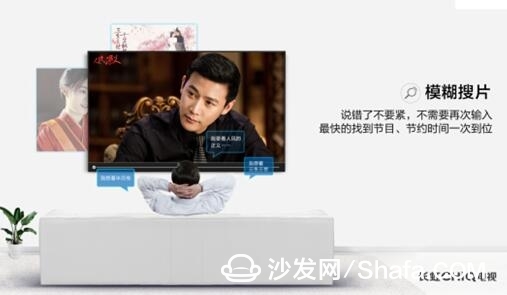After pre-market cultivation, artificial intelligence televisions are currently at the initial stage of the market, and most products are reflected in the simple interactive stage of speech recognition. The higher-level artificial intelligence interaction technology needs to be developed by enterprises.
In this context, Changhong recently launched the world's first voice-activated identification artificial intelligence TV - Changhong CHiQ TV Q5K, and launched the world's first personal smart TV technology system, will bring artificial intelligence TV into the 3.0 era.

Higher level arrival of artificial intelligence TV
The emergence of artificial intelligence televisions mainly based on speech recognition still has some problems in improving the interactive experience of users. These include:
Perceived intelligence and previous smart TVs are not significantly improved;
Many voice features are not practical enough. For example, the most obvious enhancement to the TV control experience after the voice is added is only in search. Most other functions are dispensable;
The accuracy of speech recognition is greatly influenced by external factors. Because there are many uncontrollable factors in practical application scenarios, such as dialects, environmental noise, and the speed of speech, etc., it will have a certain impact on the accuracy rate;
There is still much room for improvement in semantic understanding. For example, asking Sun Li to perform a TV series or last year's Oscars for best movies, etc., the test is the ability to understand the semantics of television. It requires precise analysis and in-depth understanding to give a satisfactory answer. High technical requirements, there is much room for exploration;
The entire voice control can't be realized, and the commonly used switch operation still depends on the remote control of the set-top box, and the voice function has become the furnishings.
For the viewing habits of different family members, it is still impossible to accurately push thousands of people.

The emergence of Changhong Q5K voiceprint recognition artificial intelligence TV will end these user pain points. It is reported that Changhong uses I-vector technology to model voiceprints. At the same time, it uses the cloud computing platform to establish a unique voiceprint database for each family member. This enables family members to be identified quickly and accurately in a home application environment. More than 90%.
According to reports, the Changhong voiceprint identification project team encountered many difficulties in the development process. In the early stage of the project, the lack of voiceprint data is one of the major difficulties, and it is impossible to effectively validate and train the established model. The voiceprint recognition algorithm needs to be able to accurately learn the differences between different speakers under the condition of enough training data. For this purpose, each member of the project team holds the remote controller on time every day and keeps shouting at Changhong Xiaobai. I want to see that I want to see it, and countless times, two times, collecting voiceprint samples day after day.
With enough data, the design of voiceprint recognition algorithms has become more important. Previously, the technical accumulation of the project team was mainly in the field of image recognition, and there was no experience in the voice-related fields, so the design of the algorithm was particularly difficult. Prof. Wu Jing, the core member of the project team, is in the United States. He is regularly scheduled twice a week through video conferencing and domestic project team members. After three months of hard work, he has finally completed the design of the algorithm, deployment of the server, and successful delivery. .
Artificial-smart TVs need to be evolving through continuous learning. They need to be used continuously for a period of time to enable televisions to have thousands of people's capabilities, and thus to increase artificial intelligence televisions to higher levels.
According to Chen Keyu, the product manager of CHiQ TV, Q5K voiceprint recognition is in use. With the accumulation of data, the voiceprint recognition model will be updated automatically. Therefore, as the user's usage time increases, the recognition rate will become higher and higher. TV will understand you more and more. Through the combination of voiceprint recognition technology and content retrieval system, Q5K can achieve thousands of thousands of personalized video content recommendations.

Layout next-generation interactive system
Based on the successful listing of CHiQ artificial intelligence, Changhong has refined and optimized the artificial intelligence TV technology from multiple dimensions such as platforms, algorithms, and protocols, thereby launching the industry's first personal smart TV technology system.
Chen Keyu introduced that the artificial intelligence TV technology system not only includes hardware and algorithms, but also includes data platform and media resources. On the hardware level, Changhong CHiQ uses an integrated array microphone to achieve far-field voice collection within 5 meters. Such as switching machine, video on demand, timing reminder and other functions. Based on tens of thousands of characters, awards, and other labels, 130,000 semantic keyword terms can be searched by characters, accurate error correction and other fuzzy search, providing users with a more interactive process experience.
Fuzzy search and accurate error correction are very important for interactive experience. Sometimes users want to watch a program, but only remember the wrong title or the name of an actor. For example, Da Kang's secretary, the system will play the name of the people for the user; for example, the user Saying that Beijing has hit Seattle, the system can automatically correct the error for users to play in Beijing and meet Seattle. Reducing the user's difficulty will increase the user's acceptance.
Although AI TVs are not yet mature, in the era of big data, the interaction mode of smart TVs must not be a remote controller, and new models will surely emerge. The system is not an Android system, but the next generation of interactive systems. Manufacturers should actively embrace the future. Peng Jianfeng, deputy secretary-general of the China Electronics Industry Association, believes that the layout of the next generation of interactive systems is strategically important to color TV manufacturers.
Changhong also launched its artificial intelligence television technology system at the forefront of its peers. Economist Guan Yixuan believes that Changhong has expanded the market application boundary and commercial development space of the traditional color TV industry with original technology, redefining the TV's function and experience in the living room scenario, which is expected to give the global color TV companies traditional hardware, Apart from the software and content competition system, a brand-new technological innovation engine is opened up, which truly opens a new path for the development of the world's color TV industry.
Smart TV/box information can focus on smart TV information network sofa butler (http://), China's influential TV box and smart TV website, providing information, communication, TV boxes, smart TVs, smart TV software, etc. Answering questions.
Description of Stacked D-Sub I/O Connectors
Antenk's connectors are designed for applications requiring multiple connector ports with limited PCB space
The condensed footprint of Antenk's dual port D-sub solution is available in four industry sizes, three connector spacing options, and six hardware configurations for one of the broadest stacked D-sub offerings on the market in standard and high-density variations.
Stacked D-sub I/O connectors are designed for applications requiring multiple connector ports with limited PCB space. Two right angle D-sub connectors are stacked one on top of another, creating a single dual-port connector with a very condensed footprint.
Features of Stacked D-Sub I/O Connectors
Available in four industry standard sizes:
Standard density: 9, 15, 25, 37
Available in three connector spacing options: 0.625", 0.750", 0.900"
Available in six hardware configurations
High-temperature UL94 V-0 thermoplastic (260°C process temp)
High performance stamped contacts
Applications of Stacked D-Sub I/O Connectors
Communications
Instrumentation
Medical
Computers/peripherals
Commercial industry
Test labs
Gaming industry
Range of of Stacked D-Sub I/O Connectors
Male Stacked D sub Connector
Female Stacked D sub ConnectorStandard Density Stacked D sub Connector
High Density Stacked D sub Connector
Dual-Port Stacked D-Sub Connectors
Dual Port (Stacked) D Sub,,Stacked D Sub I/O Connectors,Dual-Port Stacked D-Sub Connectors,Male Stacked D sub Connector, Female Stacked D sub Connector, Standard Stacked D sub Connector, High Density Stacked D sub Connector
ShenZhen Antenk Electronics Co,Ltd , https://www.antenkcon.com
